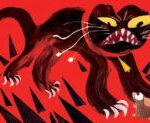When the live-action adaptation of “The Cat in the Hat” graced our screens in the early 2000s, most of us were kids, blissfully unaware of the adult humor sprinkled throughout. We were captivated by the vibrant chaos, the catchy musical numbers, and the sheer absurdity of it all. Now, as Gen Z adults, many have either forgotten this cinematic experience or, if you belong to the camp of “Cat in the Hat” detractors, actively wish to erase it from memory.
The core concept of the story is undeniably bizarre: two children left in the care of a babysitter with narcolepsy find their mundane day upended by an intruding, anthropomorphic cat who unleashes pandemonium, wreaking havoc on their home and compelling them into forced “fun.” Ironically, this chaotic essence is arguably the film’s closest adherence to the spirit of the original Dr. Seuss book. However, critical reception at the time painted a different picture. Many reviews highlighted a significant gap between expectations and reality. Critics yearned for a wholesome, nostalgic adaptation but were instead met with what they perceived as a crude, adult-joke-laden feline fiasco. Some went as far as labeling it an “artistic nightmare,” criticizing the then-cutting-edge CG as lifeless and accusing Hollywood of corrupting beloved source material. The consensus among many critics was that “The Cat in the Hat” was inappropriate and a disservice to Dr. Seuss’s legacy. The film’s reception was so negative that Audrey Geisel, Dr. Seuss’s widow, famously banned any future live-action adaptations of his works as a direct consequence. Yes, it was considered that much of a misstep.
However, it’s crucial to remember that these harsh critiques largely came from adult reviewers, perhaps not the intended audience for a children’s movie brimming with nonsensical humor. Speaking for a generation who grew up with this peculiar film, there’s a strong undercurrent of nostalgic appreciation, even love, for its outlandish charm.
Several elements coalesce to forge the unique, albeit divisive, cinematic identity of “The Cat in the Hat” live action movie. Central to this is the Cat himself, a character so deliberately over-the-top, difficult, and frankly unpleasant, that he becomes utterly comical. Despite his chaotic nature, he’s an undeniably dynamic entertainer, bending over backwards to impose his brand of “fun” upon the initially resistant children. He’s a creature of infinite resources, capable of costume changes in a blink, bursting into impromptu song, and even presenting mock infomercials for bizarre contraptions like the Kupkake-inator. He seemingly has lawyers on speed dial and effortlessly switches between accents, from a New York swagger to a Manchester lilt. He’s as comfortable delivering jokes about “drunken clowns with hepatitis” as he is nonchalantly sewing his tail back on after a self-inflicted scissor incident. His mastery of physical comedy is also undeniable; a particularly memorable scene involves a groin shot of such impact that it induces psychedelic hallucinations.
Beyond the titular cat, the characters expanded upon for the movie enrich the narrative in unexpected ways. Joan, for instance, is portrayed as a stressed single mother, juggling a demanding real estate career with the challenges of raising her mischievous son, Conrad. She’s under pressure from her germophobic boss, Mr. Humberfloob, adding another layer of comedic anxiety. We’re also introduced to Larry, Joan’s seemingly earnest love interest, who is quickly revealed to be a gold-digging opportunist plotting to dispatch Conrad to military school once he secures his financial gains through Joan. And then there’s the unforgettable Mrs. Kwan, the babysitter who achieves near-legendary status for remaining unconscious for the vast majority of the film, a running gag that epitomizes the movie’s commitment to absurdity. These quirky additions, alongside the core characters from the original Dr. Seuss book, contribute to a more fleshed-out and, arguably, more entertaining narrative, even if it veers wildly off-course from the source material’s gentle simplicity.
The movie is a relentless barrage of absurd scenarios designed to elicit laughter and perhaps a healthy dose of bewildered questioning. For example, the children’s house inexplicably transforms into a full-blown amusement park, complete with rollercoasters upon which Mrs. Kwan not only rides in her sleep but, in a surreal twist, becomes the rollercoaster itself. The extended chase scene is another highlight of bizarre humor. While a younger audience might simply find it funny, an adult viewing prompts questions like, “Why are they suddenly in an underground rave? This is supposed to be a kids’ movie! And is that Paris Hilton?” These moments of utter randomness are precisely where the movie’s charm, for its defenders, lies.
Much like the original Dr. Seuss book, the live-action “Cat in the Hat” movie was never intended to be a piece of high art or taken with utmost seriousness. Therefore, the vehemently negative reactions from some quarters seem somewhat disproportionate. Yes, it incorporates adult-oriented jokes, and yes, personal nostalgia might color the fondness some hold for it. However, at its heart, it’s a movie crafted for the generation of 2000s kids – a demographic perhaps less concerned with cinematic purity and more receptive to unadulterated silliness than middle-aged film critics. So, whether you love it or loathe it, there’s a valuable, if unconventional, takeaway: embrace the fun, lighten up a little, and maybe don’t overthink a movie about a giant cat in a hat causing delightful destruction.

